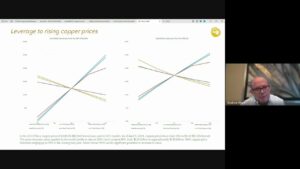Summary
- In the first half 2015 Fresnillo reported the increased production of gold and silver.
- The Fresnillo mine is losing its leading position in the company's mineral portfolio.
- Fortunately, the increased production at Saucito and Herradura covers all loses encountered at Fresnillo.
On July 22, 2015 Fresnillo plc (OTCPK:FNLPF) announced its H1 2015 production results. Apart from that, the company raised its full year 2015 gold production guidance to 715 – 730 thousand ounces (from 670 – 685 thousand ounces previously). In this article I am discussing the H1 2015 production results.
Firstly, let me summarize production results:

Source: Simple Digressions and the company's reports
As the table shows, Fresnillo increased the production of all metals. What is interesting, gold is becoming a leading metal produced by the company. Assuming the H1 2015 prices of gold and silver – gold sales should have exceed the sales generated by silver therefore Fresnillo is no longer a silver company – it is a gold / silver miner.
Below I am giving a short description of the main developments at three mines: Fresnillo, Saucito and Herradura. These mines are the biggest precious metals producers delivering 77.9% of the company's overall production.
Fresnillo mine
Fresnillo mine used to be the company's flagship operation. I am using past tense because, after putting into operation the second phase of Saucito, it is this mine that has become the leading silver producer in the company's mineral portfolio.
For a few years this excellent mine has been facing rapidly decreasing silver grades. The chart below shows the history of silver production and grades reported by the Fresnillo mine.
Source: Simple Digressions and the company's reports
Note that the H1 2015 production results, presented for Fresnillo, Saucito and Herradura have been calculated as the sum of production reported in H2 2014 and H1 2015.
As the chart shows, until 2010 the Fresnillo mine had been delivering relatively stable amounts of silver backed by high grades of 500 gram of silver per ton. Then the grades started to go down – silver production followed this rapid decrease. The company explains this situation in the following way:
This was mainly as a result of a lower silver ore grade reflecting limited access to higher ore grade areas, and lower ore volumes processed due to the instability of some stopes and the previously announced development delays at the San Carlos and San Alberto areas and the subsequent ramp-up.
The company believes it is able to stabilize ore grades in the third / fourth quarter 2015. We will see but the trend is clear – the Fresnillo mine is losing its shine as a leading operation in the company's mineral portfolio.
Saucito
Totally different picture emerges when we look at Saucito. As the chart below shows, since 2011 this mine had been delivering more and more silver. This increase has been accompanied by the increasing grades. Additionally, in Q4 2014 the company concluded the second stage of Saucito.
Source: Simple Digressions and the company's reports
Currently Saucito I and Saucito II are operating at full capacity, which should result in an annual production of around 20-21 million ounces of silver. Additionally, in 2016 Fresnillo plans to increase the Saucito total nominal capacity from 6,600 to 7,200 tons per day, which should further increase the amount of silver produced at this facility.
Herradura
Contrary to Fresnillo and Saucito, Herradura is a gold mine. The chart below shows silver production and ore grades reported by this mine:

Source: Simple Digressions and the company's reports
A decrease in production reported in 2013 and 2014 was caused by a temporary explosives suspension ordered by the Mexican court. Now the mine is working at its full capacity and in H1 2015 it delivered the record amount of gold. It is worth noting that, since 2012, the ore grades reported by Herradura, have been generally increasing. Additionally, in 2014 the company installed a new dynamic leaching plant (DLP) at Herradura, which enhanced the recovery ratios at this facility. As the company said:
Quarterly gold production including the DLP throughput increased 17.7% on Q2'14 mainly as a result of a higher overall average speed of recovery (78.02% Q2'15 vs. 46.85% Q2'14) as the ramp up to steady state at Herradura progresses, and an increase in irrigated areas on the leaching pads.
Yes, it sounds a little bit complicated but recovery ratios are one of the most important factors in the precious metals mining. Let me explain it using a few figures. In Q2 2015 as many as 5.04 million tons of ore was processed at Herradura. The ore grade was 0.71 gram per ton. In Q2 2014 Herradura processed 7.07 million tons of ore and the ore grade was 0.72. Let me put it another way – in Q2 2015 Herradura processed less ore at a lower grade than in Q2 2014. Therefore, logically, in Q2 2015 the company should have reported lower gold production at Herradura. But due to much higher speed of recovery (78.02% in Q2 2015 versus 46.85% in Q2 2014) the mine actually produced more gold (89,691 ounces in Q2 2015 versus 76,212 ounces in Q2 2014).
Summary.
In H1 2015 Fresnillo reported very decent production results. In the silver segment the company increased the production by 12.1% compared to H1 2014. In the gold segment the increase in production was even higher (37%). Taking into assumption that in H1 2015 prices of gold were lower by 6.6% than in H1 2014 and prices of silver were lower by 17.4% I guess that in H1 2015:
- in the silver segment the gross margin could be comparable or lower than that reported in H1 2014
- in the gold segment the company should report a higher gross margin than a year ago
- due to the fact that in H1 2015 gold sales should exceed silver sales, an overall gross margin should be higher than a year ago (the combined change in gold segment bigger than that reported in the silver segment).
My assumptions are summarized in the table below:

Source: Simple Digressions and the company's reports
Editor's Note: This article discusses one or more securities that do not trade on a major U.S. exchange. Please be aware of the risks associated with these stocks.
Original Article: http://seekingalpha.com/article/3356465-fresnillo-plc-reports-decent-h1-2015-production-results


























